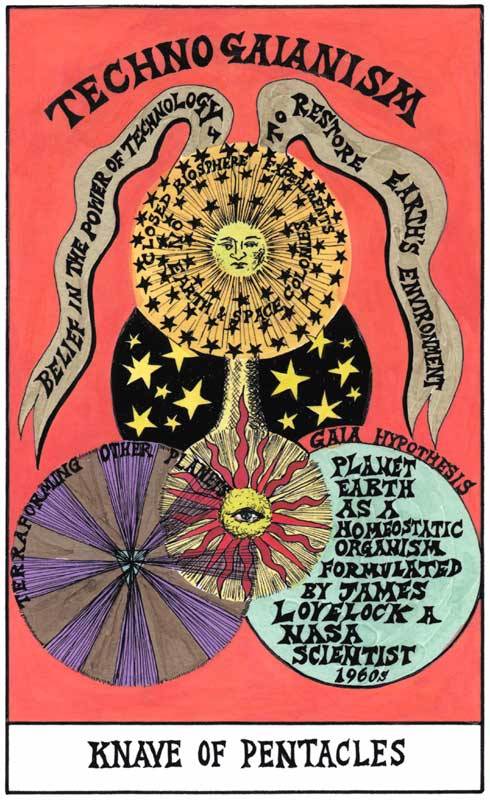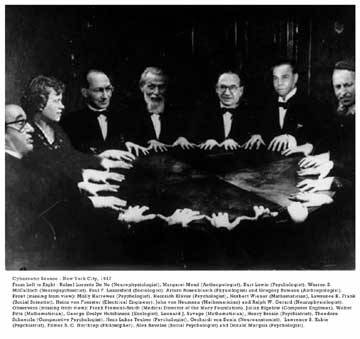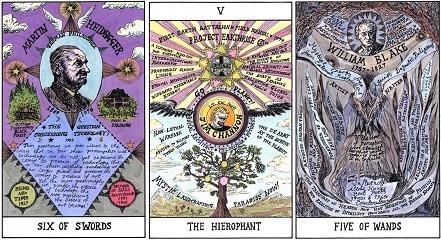#technogaianism
Photo

Knave of Pentacles. Art by Suzanne Treister, from HEXEN 2.0.
Technogaianism
26 notes
·
View notes
Text
things I like about orion's arm:
-amazing world building
-diverse cultural landscape and expansion of moral circles
-advanced and plausible technologies
-total self agency over identity and freedom
things I dislike about orion's arm:
-the world building refuses to imagine a world without hierarchical domination and says anarchism won't work in the long term.
-horrific forms of torture invented
-weird and unethical species downshifting
-cops and landlords exist even thousands of years into the future and most people still have to work a corporate job even in a post scarcity environment.
honestly I think the idea of a singularity is an interesting idea, but we also have to look at how ai is largely shaped by the working class and micro work that fuels ai data and how the public welfare of capitalist society is largly a biproduct and afterthought the primary motivation of capitalism, which is to produce capital for the owning class off the backs of the laborers. a society of care and mutual aid can be built without the need of a ruling class. there fundamentally cannot be a post scarcity society under capitalism and it will always result in exploitation. the wiki in orion's arm says that anarchism only works for a few hundred years, yet humans have lived in villages on earth in the real world for THOUSANDS of years without a clear central hierarchy and used a gift economy as the primary mode of distribution.
the kind of world I want to build is a fully liberated deep ecological pan-species technogaian queer space anarchism, which is is different from orion's arm's neoliberal space capitalism. I really think we can build a better world that doesn't rely on capitalism as the primary means of production.
13 notes
·
View notes
Text
We should do a series of mass mobilizations like the race for a COVID vaccine to wipe out hunger, disease, war, and aging.
#transhumanism#four horsemen#technogaianism#vitality for all#we could feed everyone#war is not invigorating conflict#health for all#aging is not necessary
2 notes
·
View notes
Photo

"'HEXEN 2.0 Tarot' features 78 #alchemical drawings depicting interconnected histories of the #computer and the Internet, #cybernetics and the #counterculture science-fiction and scientific projections of the future, #government and #military research programmes, social engineering and ideas of the control society; alongside diverse philosophical, literary and political responses to the advance of technology including the claims of #anarchoprimitivism #technogaianism and #transhumanism Through representing and re-examining these subjects and histories through the lens of #occult belief systems and ideas of the #supernatural the 'HEXEN 2.0 Tarot' takes us to a #hypnotic mesmerising space from where one may imagine and construct possible #alternative futures. Acknowledging precedents such as the traditional tarot deck, The Rider-Waite Tarot Deck and Aleister Crowley's #Thoth #Tarot Deck, Suzanne #Treister has here produced a Tarot, that allows a reader, to use the cards to reconfigure history and/or map out hypothetical future narratives. [For example] in tarot lore, the #Ace of Pentacles represents new beginnings, wealth and inspiration in material or financial matters, such as the energy to undertake a new business venture. In Treister’s deck, [it] conflates The Four Technologies: #nano #bio and info-technology as well as #cognitive science. [And] the drawing pulls quotes from a 2002 report commissioned by the US National Science Foundation, [titled] “Converging Technologies for Improving Human Performance.” The Three of #Swords (a card that urges to take a strong look at that which is at the centre of our world), refers in Treister’s version to CIA’s infamous #MKULTRA program, in which volunteers as well as unwitting #civilians were guinea pigs for government mind control experiments with #psychedelica Divorced from its personal application, Treister employs the tarot card for readings of a collective destiny. (at Liverpool) https://www.instagram.com/p/Cp2oQLoMo76/?igshid=NGJjMDIxMWI=
#alchemical#computer#cybernetics#counterculture#government#military#anarchoprimitivism#technogaianism#transhumanism#occult#supernatural#hypnotic#alternative#thoth#tarot#treister#ace#nano#bio#cognitive#swords#mkultra#civilians#psychedelica
1 note
·
View note
Note
I love all your art so much and I LOVE your ova 2 art!! Do you have a story/plot for it that you're willing to talk about? I love trying to piece it together just by the art so far and its so intriguing
hello @eggthew! sorry it took me a while to answer this, sometimes tumblr is a little silly with notifying me about asks (== ; )
but! thank you so much!! really, the interest in the OVA 2 series makes me so happy. i don't want to give the whole thing away just in case i actually get to write it one day (manifesting... manifesting.....) but i will say that one of the reasons why i love the original OVA is because of the very solarpunk/technogaianism things going on. so the story is similar in those themes, but it’s more tightly focused on those themes than the original, and this time mighty & ray get to be along for the ride (finally!) -- maybe it’s a bit of a long shot to say this, but i hope to one day share the whole thing with you all!
that being said, if anyone has any theories that they’ve come up with from just the 8 frames, i would love to hear them ~__^ thank you for your support and kind words!
20 notes
·
View notes
Photo

Terraform the planet into a green planet.
19 notes
·
View notes
Photo

Eco-friendly, unmanned, airborne public transportation is now real.
I had unmanned public transport drones (solar powered, of course) in the futuristic Solarpunk city of my novel The Carbon Coast, but the pending present caught up to my fictitious future! Read more on Dubai’s breakthrough in public transport.
#solarpunk#eco-friendly#drones#public transport#sustainability#environment#future#zerowaste#futurism#technogaian#ecotopia#savetheearth#transport
183 notes
·
View notes
Photo

Closeup!
Another term for Solarpunk (all new to me): Technogaianism!
Have to love that!
@vrartlive #yearofvrart - Week 31 theme: "Solarpunk / Renewable Energy".
Music by @davidforlano – thank you David!!!
3 notes
·
View notes
Text
The Cyberpunk Zeitgeist
>>>𝕄𝕜𝕕𝕚𝕣 "𝕤𝕠𝕔𝕚𝕖𝕥𝕪"...
>>>ℂ𝕕 "𝕤����𝕔𝕚𝕖𝕥𝕪"
>>>𝔻𝕠𝕨𝕟𝕝𝕠𝕒𝕕 𝕙𝕚𝕧𝕖𝕞𝕚𝕟𝕕.𝕖𝕩𝕖...
>>>𝔻𝕠𝕨𝕟𝕝𝕠𝕒𝕕 𝕔𝕠𝕣𝕡𝕠𝕣𝕒𝕥𝕖𝕜𝕝𝕖𝕡𝕥.𝕖𝕩𝕖...
>>>ℝ𝕦𝕟 𝕤𝕠𝕔𝕚𝕖𝕥𝕪.𝕖𝕩𝕖...
>>>𝕄𝕠𝕣𝕒𝕝𝕚𝕥𝕪 <𝕝𝕠𝕒𝕕𝕚𝕟𝕘-𝕗𝕒𝕚𝕝𝕖𝕕:
"𝕞𝕠𝕣𝕒𝕝𝕚𝕥𝕪.𝕙" 𝕟𝕠𝕥 𝕗𝕠𝕦𝕟𝕕>
>>>𝔼𝕣𝕣𝕠𝕣 𝕞𝕖𝕤𝕤𝕒𝕘𝕖: "ℂ𝕒𝕟𝕟𝕠𝕥 𝕗𝕚𝕟𝕕 𝕤𝕠𝕔𝕚𝕖𝕥𝕪.𝕖𝕩𝕖. 𝕎𝕖 𝕝𝕚𝕧𝕖 𝕚𝕟 𝕚𝕥."
>>>...
Flash into the past and look into the future. Recall the early stages of the digital age—the new millennium—and how, at the precipice of a thousand transformations, civilization was defined by its endless climbing innovation. In the 80’s and 90’s, when consumer use of the personal computer was infecting society like a virus, our entire idea of communication changed. The net became a pivotal point in shaping what it meant to be human. Through an ever-expanding web of information, human innovation seemed to spiral until promising “authorship over reality itself”. Those who felt constrained by the world, escaped into a fractal space with infinite possibilities of connecting with others.
Douglas Rushkoff termed it ‘Cyberia’—a dreamlike place offering “a way to crack open our civilization’s closed-mindedness, and to allow for a millennial transition that offered something a lot better than apocalypse: consciously driven evolution”, but the mesmerizing unity in this newfound cyberscape didn’t last. What followed—what we see around us now—may lead us to believe that all is lost, but perhaps there’s something more than war, corporate politics, espionage. Perhaps, there still exist some humans among us interested in a higher cause: unlocking the mysteries.
While the net was first adopted solely by military personnel and groups of scientists across academia who saw fit to interconnect themselves for research and communication purposes, it soon fell into the hands of the geeks using hypertext forums to discuss niche hobbies or send pictures to one another. The net became a mystic place of interlocking minds, where interconnected collections of data contributed to the neural network of humans that composed a global brain. As this paradise aged, however, the desire of investors to monetize and capitalize from the cyberscape arose alongside it. Advertisements flooded the web; businesses sprung up in every forum, website, and chat client. It wasn’t long into the 21st century that the nature of the web was forever molded by a greed to optimize its use for social credit, capital, and leverage for everything from corporate intelligence, to data harvesting, to control and censorship of media. The symbol of freedom and exploration was thus transformed into a stratified market and a subversive survival game. It’s all so… Cyberpunk.
In the 80’s and 90’s, alongside the rise of computers and the net, came the rise of Cyberpunk literature—a sci-fi subgenre defined by its retro aesthetics intermixed with contrasting commentary that showed us the wonders of new technology while simultaneously revealing the deep divide that emerged as a result of inequality. Pioneers like William Gibson in Neuromancer, Neal Stephenson in Snow Crash, and Katsuhiro Otomo in Akira revealed the true impact of this divide. In a world where everyone in the streets is chromed up with augmented cybernetic prostheses, but can still hardly afford to eat—a world where cities have been replaced by endlessly sprawling megalopoli—we’re left immersed in the aesthetics of ‘high tech-low life’ people struggling to get by.
Cyberpunk showed sci-fi fans what it might look like if kleptocratic corporations spiralled further and further into the power vacuum created by advancing technology. If caution and regulation aren’t put in place to protect the people from marvelous creations that humanity could hardly predict outside of science fiction, the people are further exploited and economic classes are further stratified. When this is combined with life-threatening dangers around every corner, the difference between economic class can mean life and death.
While the additional flourishes of weapons-grade cyborgs, sentient and sentimental artificial intelligence, and laser guns can make Cyberpunk seem like a farfetched reach into a future that will never come, I am here to tell you that this is Society, and we are living in it. Around the world, rising sea levels begin to swallow more of the coastline, and megafires consume any shred of nature or infrastructure in their path. Both of these events are spurred by human-driven climate change which is created in large part by first-world corporations churning out fossil fuels or slicing up rainforests for profit. The global hivemind that is the internet has become the limitless communications apparatus we wanted it to be, but it is covered in adverts and subverts its users attempts to harness its power with misinformation, propaganda, and profit-driven exclusive content. Riots over authoritarian state measures have propped up not only in the United States, but in Hong Kong, Belarus, and all across the globe. Pandemic disease and refugee crises displace hundreds of thousands of humans each year, and the rich keep getting richer by the billions.
In more recent Cyberpunk writing like William Gibson’s The Peripheral, Gibson describes the Jackpot:
And first of all that it was no one thing. That is was multicausal, with no particular beginning and no end. More a climate than an event, so not the way apocalypse stories liked to have a big event, after which everybody ran around with guns… or else were eaten alive by something that caused the big event. Not like that.
It was androgenic… that meant because of people. Not that they’d known what they were doing, had meant to make problems, but they’d caused it anyway. And in fact the actual climate, the weather, caused by there being too much carbon, had been the driver for a lot of other things. How that got worse and never better, and was just expected to, ongoing. Because people in the past, clueless as to how that worked, had fucked it all up, then not been able to get it together to do anything about it, even after they knew, and now it was too late.
...it killed 80 percent of every last person alive, over about forty years.
Jackpot. The repercussions of humanity’s actions finally catch up, and those bits of humanity that do remain are saved by an extreme surge in innovation that manages to save society’s elites. As Douglas Rushkoff puts it in his recent essay The Privileged Have Entered Their Escape Pods, more and more of those who have the capital to do so have already begun their plans, whether those plans are to escape to Mars or to set themselves up with a cushy work-from-home job while the lower class workers are forced into the public during the pandemic crisis. The need to automate away positions for the safety of our species is becoming even more prevalent than it once was in the minds of corporate conglomerates, but the cancerous overgrowth of our bureaucracy has become so bloated and tripped up in its own processes that we can no longer look to our political systems to keep up with the exploitation of innovation. Lo and behold, the world’s looking pretty CPAF to me.
Where have the visions of Cyberia gone? What happened to the early stages of internet punks, pushed aside in their desire to surf the datasphere purely for the rush of uncovering swathes of data? Where did visions of “authorship over reality itself” twist to become ‘authorship over reality by those with the capital to control’? It may seem that this explosive spiral of technological innovation in the new millennium is driving us towards extinction and only saving those with enough coins in their pockets to buy a ticket on the ark, but perhaps it’s not too late to change course and save ourselves from the ultimate Jackpot.
United by the global nature of the net, every one of us is connected as a single living entity that is the Earth—a Technogaia. Developments in artificial intelligence promises us exponential increase in information processing capabilities across all fields. Breakthroughs in genetic engineering could allow us to delete diseases from our genomes, and have already shown minor success in the de-extinction of species. With the first cyborg part already installed in each of our pockets, every citizen can extend their minds beyond capacity; each one of us becomes a journalist at a moment’s notice when injustice needs to be documented and challenged. Nuclear, hydrogen, solar, and wind energy lead us towards a cleaner and greener future. The rise of urban ecology shows a path to optimize the use of space to lower humanity’s carbon impact while providing more space for habitat rehabilitation and the reintroduction of lost biodiversity.
In the palm of our hands, humanity has taken control of the world. With science and technology, we’ve become the manipulators, but if we do not recognize what our impact is on the Dao of Earth, we may tip the scales too far into the Chaos. I’ll be honest in saying things look grim, but these same innovations that have paved the way for flying killbots and smoke stacks spewing gases into the sky have given us the power to reshape the world in a beneficial image. Futurist politicians call for universal basic income in a world increasingly run by machines. Transhumanists pave the way for the radical extension of the human lifespan. Technogaians design solarpunk arcologies to house a society ready to save their Earth rather than one intent on consuming it. Cyberians fight for our rights to privacy and the freedom of information. Just as the visions of grim dystopias in the 80's and 90’s saw themselves transformed into modern realities, we can use humanity’s greatest tool—this near-deific domain over innovation—to mold this fractal reality into our vision. But is it chaos, order, or some harmonious Dao in between that we seek?
No matter our choice, it’s going to take a lot of united high tech-low life cyberpunks to get there. This is the Cyberpunk Zeitgeist, and we’re living it.
For more works by The Cyberpunk Zeitgeist, see our Twitter page @CyborgZeitgeist
19 notes
·
View notes
Text
HEXEN 2.0 Suzanne Treister 2009-2011
today i wanna share a work by one of my favorite schizo hoes on the internet, suzanne treister, a gal all about the blending of mysticism with technology . these images and video display the "cybernetics seance," digitally altered photos of the macy conference attendees that have been edited onto an old photograph of a seance . the voices are not the attendees but performed readings of original works by the attendees . the imaginary scenario stylistically reconfigures real histories into, in treister's own words, "alchemical art forms in order to open up alternative ways of working with and thinking about the subjects ." end quote .
and the video can be viewed here : https://vimeo.com/167426446
vimeo


from her website :
HEXEN 2.0 looks into histories of scientific research behind government programmes of mass control, investigating parallel histories of countercultural and grass roots movements. HEXEN 2.0 charts, within a framework of post-WWII U.S. governmental and military imperatives, the coming together of scientific and social sciences through the development of cybernetics, the history of the internet, the rise of Web 2.0 and increased intelligence gathering, and implications for the future of new systems of societal manipulation towards a control society.
HEXEN 2.0 specifically investigates the participants of the seminal Macy Conferences (1946-1953), whose primary goal was to set the foundations for a general science of the workings of the human mind. The project simultaneously looks at diverse philosophical, literary and political responses to advances in technology including the claims of Anarcho-Primitivism and Post Leftism, Theodore Kaczynski/The Unabomber, Technogaianism and Transhumanism, and traces precursory ideas such as those of Thoreau, Warren, Heidegger and Adorno in relation to visions of utopic and dystopic futures from science-fiction literature and film.
Based on actual events, people, histories and scientific projections of the future, and consisting of alchemical diagrams, a Tarot deck, photo-text works, a video and a website, HEXEN 2.0 offers a space where one may use the works as a tool to envision possible alternative futures. (Suzanne Treister)
2 notes
·
View notes
Text
I learned a new word today: technogaianism.
I really like this word and what it represents, since it really does mesh with my take on environmentalism. Like many bright green environmentalists (which is another ideology I didn’t know about until I was today years old), I believe that:
The idea of dismantling civilization and abandoning technological development isn’t just unrealistic, it’s actively detrimental.
While protests are useful for raising awareness, practical solutions are required in order to effect repair to Earth’s damaged ecosystems.
To me, that is far more sensible than the alternatives being proposed by “green is the new black” corporate-friendly environmentalism (light green environmentalism) and the eugenicist horseshit being peddled by anarcho-primitivists eco-fascists (dark green environmentalism).
Instead, I think that the best course of action in order to halt environmental damage and begin reversing the damage done to our planet requires that we free scientific development from the shackles of capitalism and let our best and brightest minds do what they do best: solve problems. We can develop new and alternative technologies that can be used to remove carbon from the atmosphere, restore planetary albedo, clean our water and soil, and a million other things that need to be done.
In short, we need to be proactive about fixing the planet in a way that people might actually be willing to go along with. That’s technogaianism, and I love it to pieces.
2 notes
·
View notes
Text
I honestly think we need to shift the conversation about environmentalism and focus on how interconnected we are. the modernistic framework of separating the affairs of humans and nature denies the mass atrocities that are being committed in both first and second nature spaces (first nature being the domain of the non constructed primordial worlds we neglect to steward, second nature being the domain of the constructed artifice of mechanistic control). it's time we built a third nature: a new ecosystem where technology and ecology aren't at constant odds with each other and the bloodshed for survival between animals is finally ended. third nature should share the knowledge we have with the natural world. open the borders entirely. I believe it should be a moral imperative to scientifically advance the quality and capabilities of self determination, cognitive freedom, morphological freedom and self expression for all beings. not as an act of paternalism, but of equalizing solidarity. human supremacy no more. universal egalitarianism for all beings. this is the solarpunk world I desire to create. no more bloodshed over predation or disease or starvation. no more endless wars built off of mass suffering. an end to all tyranny, from nature or otherwise. when we start dismissing evils as natural, injustice is excused. we are stuck in trauma cycle realism that we must break out of that. this pain will end some day and we will all heal. it's time for humans and animals to break the status quo. we cannot sustain a world built on suffering. period.
#end human supremacy#wild animal liberation#anarcho sophontism#total liberation#solarpunk#transformative justice#technogaianism#veganize the planet
5 notes
·
View notes
Text
Potential names for my political philosophy
Salvagepunk Ecology
Left-Animalism
Post-Civ Marxism
Post-Left Marxism
Left-Dionysianism
1 note
·
View note
Text
Fellow Tarot people: I just got an unusual deck, Hexen 2.0. I hadn’t seen it before, so I thought I’d mention it here in case anyone might have missed it like I did.

It’s by Suzanne Treister, and she describes it as follows:
HEXEN 2.0 looks into histories of scientific research behind government programmes of mass control, investigating parallel histories of countercultural and grass roots movements. HEXEN 2.0 charts, within a framework of post-WWII U.S. governmental and military imperatives, the coming together of diverse scientific and social sciences through the development of cybernetics, the history of the internet, the rise of Web 2.0 and increased intelligence gathering, and the implications for the future of new systems of societal manipulation towards a control society.
HEXEN 2.0 specifically investigates the participants of the seminal Macy Conferences (1946-1953), whose primary goal was to set the foundations for a general science of the workings of the human mind. The project simultaneously looks at diverse philosophical, literary and political responses to advances in technology including the claims of Anarcho-Primitivism and Post Leftism, Theodore Kaczynski/The Unabomber, Technogaianism and Transhumanism, and traces precursory ideas such as those of Thoreau, Warren, Heidegger and Adorno in relation to visions of utopic and dystopic futures from science-fiction literature and film.
#I couldn't resist a deck#that included both Blake and Heidegger#I am not so keen on the art#but I'm into everything else that's going on here#tarot
35 notes
·
View notes